-
Welcome to Avian Avenue! To view our forum with less advertisments please register with us.
Memberships are free and it will just take a moment. Click here
Outdoor Parakeet Aviary
- Thread starter Destiny
- Start date
- Joined
- 6/6/20
- Messages
- 2,088
- Real Name
- Destiny
Not really. I'll cross that bridge when I come to it. I don't plan on using any herbicides or pesticides for obvious reasons. Although there are a few treatments which are safe to use around birds, like diatomaceous earth to kill small insects.What about plant diseases? Any worries?
If a plant gets sick or doesn't tolerate being in the aviary, I will probably just remove it. Then I can treat the individual plant and replace it with a healthy one.
- Joined
- 6/6/20
- Messages
- 2,088
- Real Name
- Destiny
Aviary Update
It has been a few days and the parakeets are settling in nicely. They spent most of the first day on the ground, but they slowly started to build up confidence as the day progressed
Here they are "perching" on the rungs of a chair.
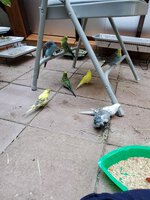
Then they moved up a few feet. Halfway there!
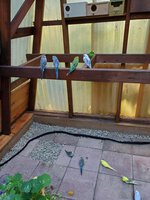
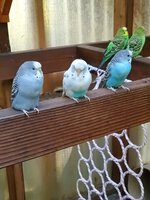
By the end of the day, most of the parakeets were roosting on this branch and this is where they spent the night.
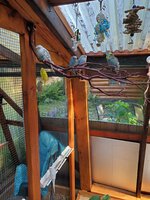
On the second day, they were spending most of their time up in the branches and freely flying from place to place. They had learned how to be birds!
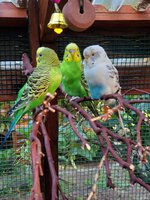
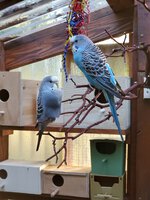
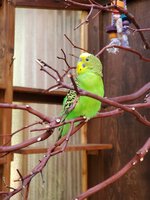
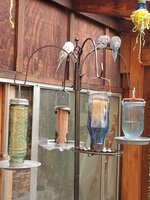
Action shot!
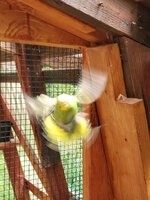
Unfortunately, some of my birds can't fly. Opal, Misty, and Sparky have no primaries. They were severely clipped when I got them and have not yet grown new flight feathers.
Despite this disability, they are able to reach some branches by climbing. They spend a lot of time on this branch because the wire mesh creates a natural access path. I added a ladder and extra perches so the whole flock can join them.
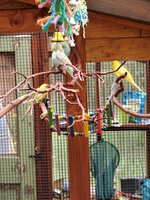
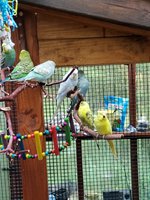
The finches are doing great. Crimson and Blaze are curious and adventurous. They swoop from branch to branch like rainbow-colored missiles. And they have been hopping around, dancing, and singing constantly. Happy, happy finches.
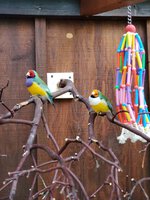
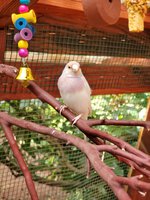
Here they are scoping out my latest offerings. I was so proud to see them eating their veggies.
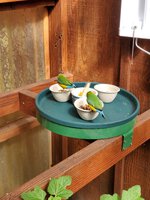
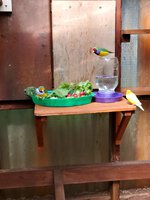
Meanwhile, Jasper and Sterling have claimed a nest box, just in case I ever decide to get them some lady finches. They are so ready.
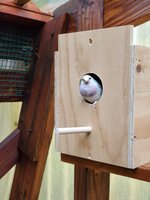
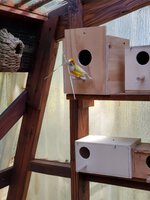
The quail are also happy and healthy. And glad that the parakeets are finally off the ground.
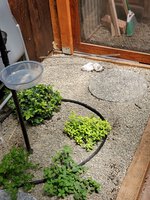
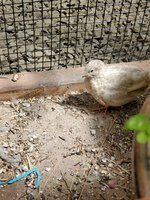
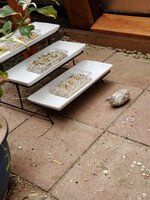
Most of the time, anyways.
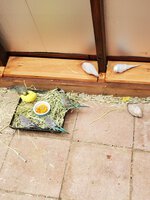
I added a dustbath for the quail. I haven't managed to catch them using it, but someone must be kicking all that sand out.
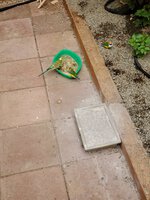
The birds are doing well and they survived Fourth of July fireworks without any issues. Thank you everyone for the kind comments. I've enjoyed sharing this journey from greenhouse to aviary. You can expect more pictures later on. I'll be spending a lot of time out here.
It is awesome.
It has been a few days and the parakeets are settling in nicely. They spent most of the first day on the ground, but they slowly started to build up confidence as the day progressed
Here they are "perching" on the rungs of a chair.

Then they moved up a few feet. Halfway there!


By the end of the day, most of the parakeets were roosting on this branch and this is where they spent the night.

On the second day, they were spending most of their time up in the branches and freely flying from place to place. They had learned how to be birds!




Action shot!

Unfortunately, some of my birds can't fly. Opal, Misty, and Sparky have no primaries. They were severely clipped when I got them and have not yet grown new flight feathers.
Despite this disability, they are able to reach some branches by climbing. They spend a lot of time on this branch because the wire mesh creates a natural access path. I added a ladder and extra perches so the whole flock can join them.


The finches are doing great. Crimson and Blaze are curious and adventurous. They swoop from branch to branch like rainbow-colored missiles. And they have been hopping around, dancing, and singing constantly. Happy, happy finches.


Here they are scoping out my latest offerings. I was so proud to see them eating their veggies.


Meanwhile, Jasper and Sterling have claimed a nest box, just in case I ever decide to get them some lady finches. They are so ready.


The quail are also happy and healthy. And glad that the parakeets are finally off the ground.



Most of the time, anyways.

I added a dustbath for the quail. I haven't managed to catch them using it, but someone must be kicking all that sand out.

The birds are doing well and they survived Fourth of July fireworks without any issues. Thank you everyone for the kind comments. I've enjoyed sharing this journey from greenhouse to aviary. You can expect more pictures later on. I'll be spending a lot of time out here.
It is awesome.
Last edited:
- Joined
- 6/6/20
- Messages
- 2,088
- Real Name
- Destiny
**Aviary Update**
Time for some happy bird pictures.
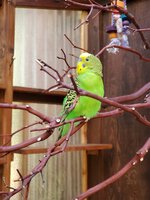
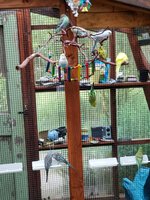

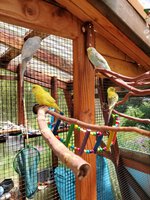
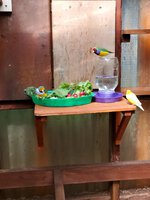
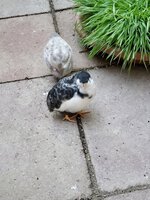
I also have some exciting news to report. Over a month ago, I was contacted by a lady who was looking to rehome her three parakeets. She had read about my aviary build on social media and felt they would be happier joining my birds. The new parakeets passed through quarantine with a clean bill of health and are now ready to be introduced to the aviary inhabitants.
First, I moved their temporary cage in to the aviary and monitored how the other birds reacted to the new arrivals. Everyone was fascinated by this strange new toy filled with birds.
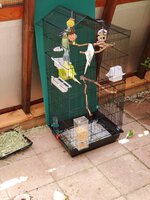
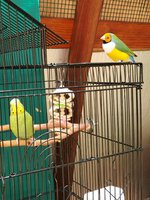
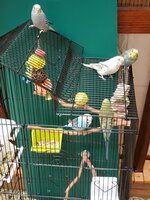
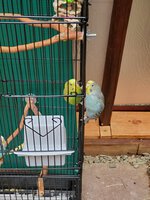
I left them in the cage for one full day to adjust to aviary conditions. The next day, I let them free and watched them closely to make sure that no one bothered them. They integrated with the existing parakeet flock without any trouble.
The three new birds are all girls. This is June. She is a little shy, but very acrobatic.
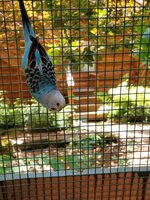
The yellow bird on the branch is Goldie. She is quite hand-tame and very sweet.
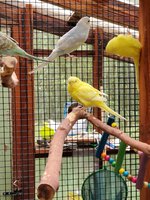
And this green lady is Johnny Girl. She is an excellent flier and spends a lot of time hanging out with Kiwi and Cucumber.
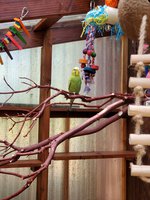
The new birds have settled in nicely and I couldn't be happier.
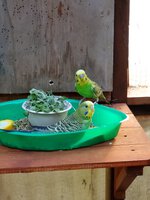

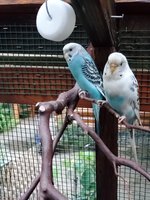
I also added a new feature - sisal rope perches to help assist the clipped birds to reach more branches. The fully-fighted birds also seem to appreciate having new options.
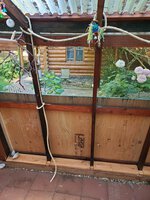

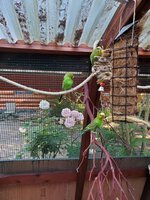
Time for some happy bird pictures.






I also have some exciting news to report. Over a month ago, I was contacted by a lady who was looking to rehome her three parakeets. She had read about my aviary build on social media and felt they would be happier joining my birds. The new parakeets passed through quarantine with a clean bill of health and are now ready to be introduced to the aviary inhabitants.
First, I moved their temporary cage in to the aviary and monitored how the other birds reacted to the new arrivals. Everyone was fascinated by this strange new toy filled with birds.




I left them in the cage for one full day to adjust to aviary conditions. The next day, I let them free and watched them closely to make sure that no one bothered them. They integrated with the existing parakeet flock without any trouble.
The three new birds are all girls. This is June. She is a little shy, but very acrobatic.

The yellow bird on the branch is Goldie. She is quite hand-tame and very sweet.

And this green lady is Johnny Girl. She is an excellent flier and spends a lot of time hanging out with Kiwi and Cucumber.

The new birds have settled in nicely and I couldn't be happier.



I also added a new feature - sisal rope perches to help assist the clipped birds to reach more branches. The fully-fighted birds also seem to appreciate having new options.



Omg the first photo is so pretty!!!!**Aviary Update**
Time for some happy bird pictures.
View attachment 346718 View attachment 346720 View attachment 346721
View attachment 346722
View attachment 346723 View attachment 346724
I also have some exciting news to report. Over a month ago, I was contacted by a lady who was looking to rehome her three parakeets. She had read about my aviary build on social media and felt they would be happier joining my birds. The new parakeets passed through quarantine with a clean bill of health and are now ready to be introduced to the aviary inhabitants.
First, I moved their temporary cage in to the aviary and monitored how the other birds reacted to the new arrivals. Everyone was fascinated by this strange new toy filled with birds.
View attachment 346747
View attachment 346743
View attachment 346744
View attachment 346748
I left them in the cage for one full day to adjust to aviary conditions. The next day, I let them free and watched them closely to make sure that no one bothered them. They integrated with the existing parakeet flock without any trouble.
The three new birds are all girls. This is June. She is a little shy, but very acrobatic.
View attachment 346749
The yellow bird on the branch is Goldie. She is quite hand-tame and very sweet.
View attachment 346750
And this green lady is Johnny Girl. She is an excellent flier and spends a lot of time hanging out with Kiwi and Cucumber.
View attachment 346751
The new birds have settled in nicely and I couldn't be happier.
View attachment 346752
View attachment 346753
View attachment 346754
I also added a new feature - sisal rope perches to help assist the clipped birds to reach more branches. The fully-fighted birds also seem to appreciate having new options.
View attachment 346755 View attachment 346756 View attachment 346757
Also does candy corn finch have a name? Right now I just squeal 'Candy Corn' inside when I see him/her in photos
And you have some really pretty budgies!
- Joined
- 6/6/20
- Messages
- 2,088
- Real Name
- Destiny
The yellow-backed finch is Jasper. He is my friendliest finch and I am trying to get him hand-tame. He is such a cutie. Look at him posing for the camera.

The silver-backed finch is Sterling. Jasper and Sterling spend a lot of time together and also like to build nests together. They are both boys, unless the breeder made a mistake. It is kind of hard to tell with silvers.
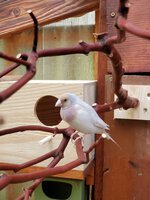
This is Blaze. He is a green backed Gouldian finch with an orange head and white breast.
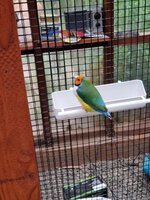
And this is his partner in crime, Crimson. Such a proud and pretty boy.
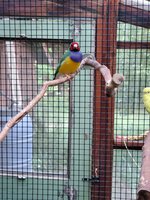
I love the bright colors and equally bright personalities of my little finches. They are beautiful and fun.
....
In the wild, Lady Gouldian finches are commonly seen with three different possible head colors - red, black, or yellow (orange). They were originally believed to be completely different species of finch before it was determined that the different head colors were natural color variations within the species.
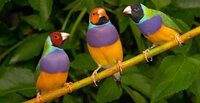
Female coloring is more muted than male coloring, but still quite striking. The bird on the left is male and the bird on the right is female. All my finches are male.
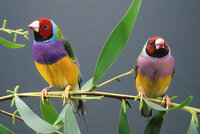
In captivity, different color mutations have been developed that affect the color of the bird's back - yellow, silver, and blue finches. Breast color can also vary from purple, lilac, or white. I don't have any black-headed or blue-backed finches, but I really want one. They are gorgeous.
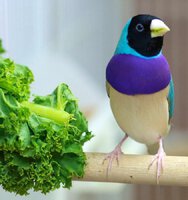
Some day ...

The silver-backed finch is Sterling. Jasper and Sterling spend a lot of time together and also like to build nests together. They are both boys, unless the breeder made a mistake. It is kind of hard to tell with silvers.

This is Blaze. He is a green backed Gouldian finch with an orange head and white breast.

And this is his partner in crime, Crimson. Such a proud and pretty boy.

I love the bright colors and equally bright personalities of my little finches. They are beautiful and fun.
....
In the wild, Lady Gouldian finches are commonly seen with three different possible head colors - red, black, or yellow (orange). They were originally believed to be completely different species of finch before it was determined that the different head colors were natural color variations within the species.

Female coloring is more muted than male coloring, but still quite striking. The bird on the left is male and the bird on the right is female. All my finches are male.

In captivity, different color mutations have been developed that affect the color of the bird's back - yellow, silver, and blue finches. Breast color can also vary from purple, lilac, or white. I don't have any black-headed or blue-backed finches, but I really want one. They are gorgeous.

Some day ...
I love Jasper!!! But they're all really beautiful!The yellow-backed finch is Jasper. He is my friendliest finch and I am trying to get him hand-tame. He is such a cutie. Look at him posing for the camera.
View attachment 346771
The silver-backed finch is Sterling. Jasper and Sterling spend a lot of time together and also like to build nests together. They are both boys, unless the breeder made a mistake. It is kind of hard to tell with silvers.
View attachment 346772
This is Blaze. He is a green backed Gouldian finch with an orange head and white breast.
View attachment 346770
And this is his partner in crime, Crimson. Such a proud and pretty boy.
View attachment 346773
I love the bright colors and equally bright personalities of my little finches. They are beautiful and fun.
....
In the wild, Lady Gouldian finches are commonly seen with three different possible head colors - red, black, or yellow (orange). They were originally believed to be completely different species of finch before it was determined that the different head colors were natural color variations within the species.
View attachment 346776
Female coloring is more muted than male coloring, but still quite striking. The bird on the left is male and the bird on the right is female. All my finches are male.
View attachment 346778
In captivity, different color mutations have been developed that affect the color of the bird's back - yellow, silver, and blue finches. Breast color can also vary from purple, lilac, or white. I don't have any black-headed or blue-backed finches, but I really want one. They are gorgeous.
View attachment 346779
Some day ...
Thanks for explaining the colours
Something about finch feathers - they look so perfect and flawless. When I was at the store and saw these long tailed finches, they looked almost fake cause you can't see the individual feathers but just solid colourations. Not sure if this makes sense
UGH! UGH! UGH! I SO SO SO HATE YOU!!!
No seriously, i’m obviously kidding but DAMN am i looking green, purple, red and yelow out of jealousy
NICE! VERY! VERY NICE!
one thing though.. are you not worried the keets will demolish all the wooden paneling? And then escape?
No seriously, i’m obviously kidding but DAMN am i looking green, purple, red and yelow out of jealousy
NICE! VERY! VERY NICE!
one thing though.. are you not worried the keets will demolish all the wooden paneling? And then escape?
Hi @Destiny !
Two questions...
What is the coldest temperature you get?
Will you take the gouldians in for winter (I read they struggle with cold)?
Thanks!
Also, @jh81 ,

Two questions...
What is the coldest temperature you get?
Will you take the gouldians in for winter (I read they struggle with cold)?
Thanks!
Also, @jh81 ,
In four years I have never had a problemone thing though.. are you not worried the keets will demolish all the wooden paneling? And then escape?
- Joined
- 6/6/20
- Messages
- 2,088
- Real Name
- Destiny
I'm not too worried about it, but I am monitoring the situation. A dozen hormonal budgie hens can do quite a bit of chewing. So far, they have mostly directed their efforts at the various chew toys and boxes I've set out for them, but they obviously don't just stop at chewing what they are SUPPOSED to chew. They are parrots, after all.one thing though.. are you not worried the keets will demolish all the wooden paneling? And then escape?
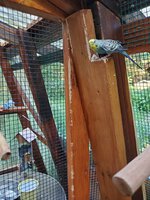
Caught in the act!
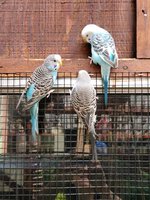
Most places they are chewing are not structural significant. I've added a few pieces of wood in prime chewing locations to discourage them from nibbling on the finished wood and to protect the aviary from long-term damage, since it is easier to replace a piece of scrap wood than an entire window sill, but so far, they aren't trying to drill holes through the walls so much as rounding off all the sharp edges.
This weekend, I need to get up on a ladder and block off the area behind this piece of wood. Both Snowball and the finches think it might work as a nest site and I am against that idea.
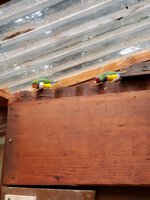
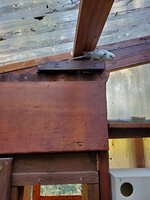
What a stunning aviary! Your flock are such a joy to see. 

- Joined
- 6/6/20
- Messages
- 2,088
- Real Name
- Destiny
I live in a mild temperate climate, so it does get cold in the winter, but it rarely snows or stays below freezing for too long, even in the dead of winter. If you know plant hardiness zones, I'm in zone 8b, with average lows around 15 to 20 F.Hi @Destiny !
Two questions...
What is the coldest temperature you get?
Will you take the gouldians in for winter (I read they struggle with cold)?
I plan on providing supplemental heating in a couple of ways and completely sheltering the birds from wind and rain. I'm pretty confident that the parakeets and quail will be fine, but I do worry about the finches, since they can be more sensitive to cold temperatures and are generally more fragile. At this point, I intend to watch them closely and move the birds inside if they show signs of distress or if the weather takes a bad turn.
On the other side of the temperature scale, we have been having an unusually hot summer so far, with multiple days in the upper eighties and nineties this week, but I think my cooling measures are doing a decent job keeping the birds comfortable. It helps that one side of the aviary is shaded for most of the day, so there is a noticeable temperature gradient as you move from one side to the other. The more shaded side stays pretty comfortable, even at mid day.
I also decided to open up the extension to let the birds have somewhere even cooler to explore, if they wanted.
When I converted the greenhouse, I removed a large ventilation fan from the back wall. Rather than simply blocking the hole, I decided to use it as a passageway. On the back wall of the aviary, I added this structure.
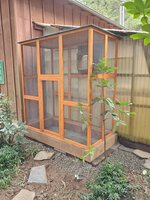
It is a an outdoor aviary/cat enclosure kit that I got off Amazon, because woodworking is hard. I was worried about predators and/or my own dogs busting through the cheap wire, so I bulked it up with some sturdy wood siding.
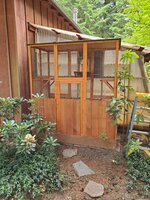
Then I added food, water, perches and toys for the birds.
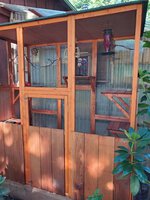
This side of the aviary is completely shaded by a large fir tree and it gets a nice cross-breeze, so it stays noticably cooler than the main aviary. I've seen a few of the birds poke their heads inside to check it out, but I haven't managed to catch them on camera. Overall, they seem to prefer the main aviary, probably because it is bigger and full of birds. But .. hey .. at least they have options!
As a bonus, the opening in the wall allows a nice breeze into the main aviary which is quite pleasant in the heat. When the cold weather comes, I plan to cover the hole to block off the draft. I kept the hole covered for the first couple weeks after releasing the birds, because I didn't want any of my flight-challenged birds to get lost or trapped in the smaller section by mistake. At this point, I think everyone is able to navigate the aviary well enough that shouldn't be a problem.
Here you can see the covered hole. Notice the "landing pad" in front of the board. I need to take a picture of it after I opened it up.
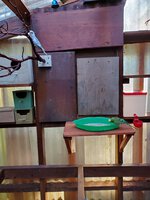
And here it is from the other side with a matching landing pad/cat platform.
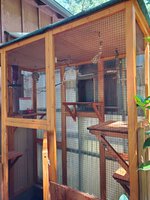
The entire extension is 4'x6'x6' which sounded really big when I bought it online, but ended up feeling pretty tiny in comparison to the main aviary.
Last edited:
This is all really impressive! Did you build it all by yourself? I would love to do the same in future if I ever own a propertyI live in a mild temperate climate, so it does get cold in the winter, but it rarely snows or stays below freezing for too long, even in the dead of winter. If you know plant hardiness zones, I'm in zone 8b, with average lows around 15 to 20 F.
I plan on providing supplemental heating in a couple of ways and completely sheltering the birds from wind and rain. I'm pretty confident that the parakeets and quail will be fine, but I do worry about the finches, since they can be more sensitive to cold temperatures and are generally more fragile. At this point, I intend to watch them closely and move the birds inside if they show signs of distress or if the weather takes a bad turn.
On the other side of the temperature scale, we have been having an unusually hot summer so far, with multiple days in the upper eighties and nineties this week, but I think my cooling measures are doing a decent job keeping the birds comfortable. It helps that one side of the aviary is shaded for most of the day, so there is a noticeable temperature gradient as you move from one side to the other. The more shaded side stays pretty comfortable, even at mid day.
I also decided to open up the extension to let the birds have somewhere even cooler to explore, if they wanted.
When I converted the greenhouse, I removed a large ventilation fan from the back wall. Rather than simply blocking the hole, I decided to use it as a passageway. On the back wall of the aviary, I added this structure.
View attachment 346915
It is a an outdoor aviary/cat enclosure kit that I got of Amazon, because woodworking is hard. I was worried about predators and/or my own dogs busting through the cheap wire, so I bulked it up with some sturdy wood siding.
View attachment 346918
Then I added food, water, perches and toys for the birds.
View attachment 346917
This side of the aviary is completely shaded by a large fir tree and it gets a nice cross-breeze, so it stays noticably cooler than the main aviary. I've seen a few of the birds poke their heads inside to check it out, but I haven't managed to catch them on camera. Overall, they seem to prefer the main aviary, probably because it is bigger and full of birds. But .. hey .. at least they have options!
As a bonus, the opening in the wall allows a nice breeze into the main aviary which is quite pleasant in the heat. When the cold weather comes, I plan to cover the hole to block off the draft. I kept the hole cover for the first couple weeks after releasing the birds, because I didn't want any of my flight-challenged birds to get lost or trapped in the smaller section by mistake. At this point, I think everyone is able to navigate the aviary well enough that shouldn't be a problem.
Here you can see the covered hole. Notice the "landing pad" in front of the board. I need to take a picture of it after I opened it up.
View attachment 346919
And here it is from the other side with a matching landing pad/cat platform.
View attachment 346921
The entire extension is 4'x6'x6' which sounded really big when I bought it online, but ended up feeling pretty tiny in comparison to the main aviary.
- Joined
- 6/6/20
- Messages
- 2,088
- Real Name
- Destiny
I assembled the pieces, but I bought it as a kit online. The only tools needed were a screwdriver, power drill, and a hammer. No actual wood-working skills required. This is the product I used:
It is intended as a cat enclosure, rather than an aviary, but it was exactly the right dimensions to fit my space, I liked the design, and the wire spacing was appropriate for finches and parakeets.
Unfortunately, as I have found in the past when buying these kind of pet products, the build quality is quite low. The wood is VERY light and flimsy. I jokingly call the wood they use for these things "balsa wood" because it is so soft and rots out quickly in my wet climate. I will probably need to replace the entire thing in a few years, if the roof lasts that long.
It has a very flat roof that is already starting to warp and leak along the seams. It doesn't matter for my application, because the birds have plenty of dry places to go when it rains. However, if someone wanted to use this as a stand-alone aviary, I would advise against it, because there is no proper shelter and it will not hold up to the elements. The wire is also a very thin guage - thinner than chicken wire. It provides minimal protection against predators.
I think this product would work as a supervised outdoor exercise cage, especially if you set it up on a covered patio or somewhere sheltered from wind and rain. I wouldn't recommend keeping birds in it outside overnight unless you are prepared to do some serious modifications. Alternatively, you could use it as an indoor aviary, as long as you had enough space and figured out a flooring solution.
If you are planning to use a product like this one as an aviary, I would also suggest removing the flimsy wire mesh and replacing it with a better quality wire that is bird-safe. Zinc from galvanized wire can cause heavy metal toxicity in birds. You can remove surface zinc by washing the wire with vinegar occasionally, but switching to stainless steel or coated wire would be better in the long run.
Amazon.com : PawHut 71" x 39" x 71" Large Wooden Outdoor Cat Enclosure Catio Cage with 6 Platforms : Pet Supplies
Amazon.com : PawHut 71" x 39" x 71" Large Wooden Outdoor Cat Enclosure Catio Cage with 6 Platforms : Pet Supplies
www.amazon.com
It is intended as a cat enclosure, rather than an aviary, but it was exactly the right dimensions to fit my space, I liked the design, and the wire spacing was appropriate for finches and parakeets.
Unfortunately, as I have found in the past when buying these kind of pet products, the build quality is quite low. The wood is VERY light and flimsy. I jokingly call the wood they use for these things "balsa wood" because it is so soft and rots out quickly in my wet climate. I will probably need to replace the entire thing in a few years, if the roof lasts that long.
It has a very flat roof that is already starting to warp and leak along the seams. It doesn't matter for my application, because the birds have plenty of dry places to go when it rains. However, if someone wanted to use this as a stand-alone aviary, I would advise against it, because there is no proper shelter and it will not hold up to the elements. The wire is also a very thin guage - thinner than chicken wire. It provides minimal protection against predators.
I think this product would work as a supervised outdoor exercise cage, especially if you set it up on a covered patio or somewhere sheltered from wind and rain. I wouldn't recommend keeping birds in it outside overnight unless you are prepared to do some serious modifications. Alternatively, you could use it as an indoor aviary, as long as you had enough space and figured out a flooring solution.
If you are planning to use a product like this one as an aviary, I would also suggest removing the flimsy wire mesh and replacing it with a better quality wire that is bird-safe. Zinc from galvanized wire can cause heavy metal toxicity in birds. You can remove surface zinc by washing the wire with vinegar occasionally, but switching to stainless steel or coated wire would be better in the long run.
RainbowFlo
Sprinting down the street
I absolutely LOVE your aviary! I'd love to have one one day  My favourites are definitely the budgies but the finch colourings are so pretty
My favourites are definitely the budgies but the finch colourings are so pretty  Thank you for sharing so many pics
Thank you for sharing so many pics 
~Estella
 Thank you for sharing so many pics
Thank you for sharing so many pics ~Estella

tka
Rollerblading along the road
Avenue Veteran
Celebirdy of the Month
Mayor of the Avenue
Avenue Spotlight Award
Thank you for sharing so many photos and for documenting the build so clearly! It's really nice to see the birds' personalities emerge in the space and in the context of the flock. They're seriously living the dream.
- Joined
- 6/6/20
- Messages
- 2,088
- Real Name
- Destiny
**Small Update**
Just wanted to share a little discovery I made. The button quails are laying eggs!
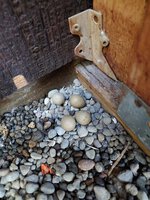
Well, to be more accurate, at least one quail is laying. I have four quail, but I don't know how many are female/male.
As you can see, quail are not big into nest building. I've so far discovered eggs in four different spots, laid directly on the floor, usually close to the wall or in a corner.
From left to right, the quail are named Clay, Terra, Slate, and Geo.
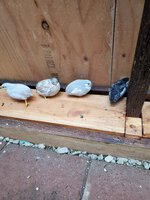
I am pretty sure that Terra is the lone female. I have observed both Geo and Clay mating with her and I saw Slate doing a call that sounded like a mating call. I haven't actually witnessed any egg laying or setting, but since everyone's interested in Terra, I'm betting she is the hen. There is a small possibility that Slate is female, so I've been checking each day to see if I get more than one egg on the same day. So far I've only found one or none.
I'm not interested in allowing the button quails to breed, since they all came from the same breeder at the same time and they are probably too closely related to provide robust offspring. So I have been gathering the eggs as I find them. If I do have three males, I will probably need to separate or sell two of the boys. From what I've read, buttons can be kept in a colony setting, but they prefer to be in mated pairs. And if you do keep a group, it is better to have a higher female to male ratio.
Also, quail eggs make the tiniest little hardboiled eggs that I have ever seen!
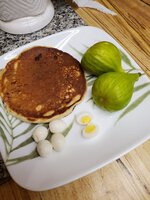
So cute that I felt a little bad eating them ...but they really are quite tasty and I hate to just throw them out.
Just wanted to share a little discovery I made. The button quails are laying eggs!

Well, to be more accurate, at least one quail is laying. I have four quail, but I don't know how many are female/male.
As you can see, quail are not big into nest building. I've so far discovered eggs in four different spots, laid directly on the floor, usually close to the wall or in a corner.
From left to right, the quail are named Clay, Terra, Slate, and Geo.

I am pretty sure that Terra is the lone female. I have observed both Geo and Clay mating with her and I saw Slate doing a call that sounded like a mating call. I haven't actually witnessed any egg laying or setting, but since everyone's interested in Terra, I'm betting she is the hen. There is a small possibility that Slate is female, so I've been checking each day to see if I get more than one egg on the same day. So far I've only found one or none.
I'm not interested in allowing the button quails to breed, since they all came from the same breeder at the same time and they are probably too closely related to provide robust offspring. So I have been gathering the eggs as I find them. If I do have three males, I will probably need to separate or sell two of the boys. From what I've read, buttons can be kept in a colony setting, but they prefer to be in mated pairs. And if you do keep a group, it is better to have a higher female to male ratio.
Also, quail eggs make the tiniest little hardboiled eggs that I have ever seen!

So cute that I felt a little bad eating them ...but they really are quite tasty and I hate to just throw them out.
Last edited:
Slate is my favorite! 





